|
| |
Back to Homebuilts
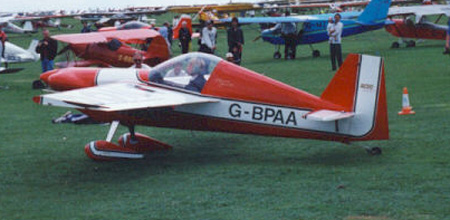 |
The Acro Advanced is a one-off single seat
design by aerobatic specialist Barry Smith. It first flew in
September 1994 and has been a regular visitor to various fly-ins
ever since. It is powered by a 65hp Acro engine, being essentially a
VW modified with fuel injection and an inverted oil system.
This picture was taken at
Cranfield in July 1998 |
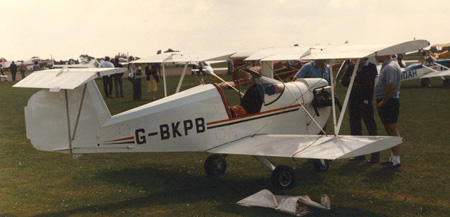 |
The diminutive Aerosport Scamp was designed
in the USA by H.L. Woods, and first flew in August 1973. It is a
diminutive machine, only 14 feet long with a wing span of 17 feet 6
inches, with a gross weight of only 770lb despite being largely
metal. Its 60hp VW engine gives it a top speed of 95mph, but such a
tiny machine can't carry much fuel so its range is only 150 miles.
Needless to say it is a single seater.
This one was at
Cranfield, July 1998 |
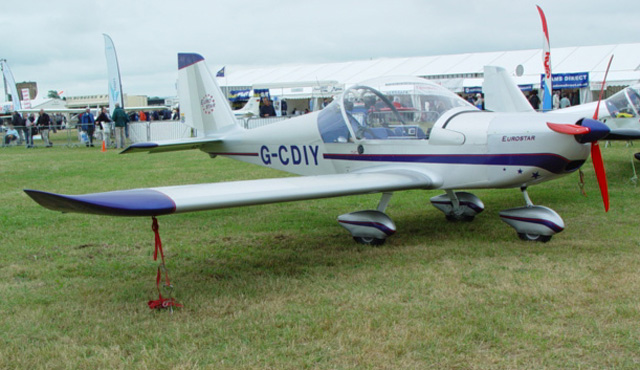 |
The Aerotechnik EV97 Eurostar is a
substantial update of the Pottier P-220, developed by Evektor in the
Czech Republic (www.evektor.cz/at/en). It is an all metal machine,
available either factory built or as a homebuilt kit. It can be
powered by an 80hp Rotax or Jabiru engine or, optionally, by a 100hp
Rotax. It is a two seater with a gross weight of 990lb. It cruises
at 110mph and has a range of 460 miles. As of April 2006, over 400
had been sold.
Photograph by Ivy at Kemble, July 2005 |
 |
The Air Command Gyroplane is a single seat
autogyro available as a kit or factory built from Air Command in
Texas (www.aircommand.com).
There are many different models, the principal differences between
them lying in the engine, which ranges from 40 to 70hp. The one
pictured here has a 65hp Rotax 532. It is a single seater, able to
cruise at 65mph and weighing a mere 615lb (all up). Limited fuel
restricts the range to 100 miles.
Photograph by Ivy at Kemble, July 2005 |
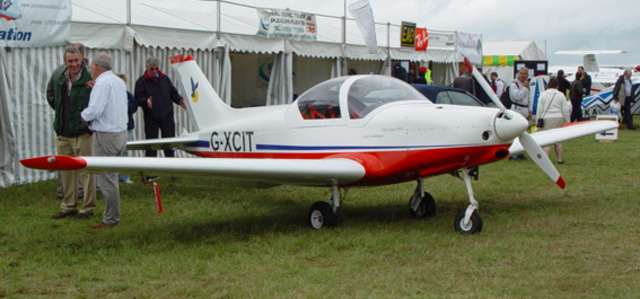 |
The Alpi Pioneer 300 is an elegant Italian
kit aircraft, essentially comprising a wooden frame (easy to work
with) and a composite skin (for smooth finish and easy moulding of
complex curves). A two seater, it can be powered by a variety of
engines in the 80 to 120hp range, most usually Rotax or Jabiru; a
more exotic option is the 110hp Mid-West Hawk Wankel rotary engine.
Although the same gross weight as the Eurostar (990lb), the claimed
performance is better: cruising speed of 155mph and range of 625
miles. It first flew around 1998 and is becoming increasingly
popular. It is 20 feet 4 inches long, with a wing span of 26 feet 4
inches. More information is available from
www.alpiaviation.com
Photograph by Ivy at Kemble, July 2005 |
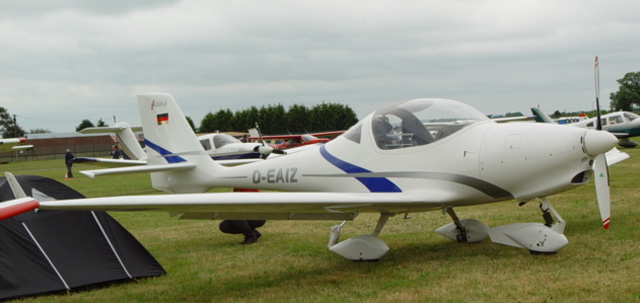 |
The Aquila A-210 is a new generation kit
available from Aquila Aviation in Germany (www.aquila-aero.com).
A two seater, it is much larger and heavier than competing designs
like the Eurostar and Pioneer, weighing in at 1,650lb but powered by
a similar Rotax 100hp engine. It cruises at 150mph and has a range
of 700 miles. It is 24 feet long with a wing span of 33 feet 10
inches. Judging by appearances (dangerous), this design has a good
future ahead of it. Photograph
by Ivy at Kemble, July 2005 |
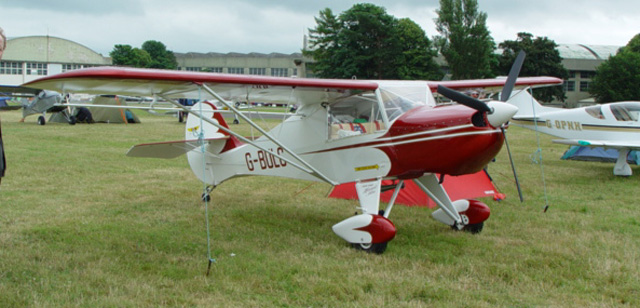 |
The Avid Speedwing is a very light (850lb
gross weight) two seat kit aircraft, of mixed metal tube, wood and
fabric construction. Normally powered by a 65hp Rotax 532 engine, it
manages a cruising speed of up to 110mph and range of 300 miles. It
is a simple little fun machine.
Photograph by Ivy at Kemble, July 2005 |
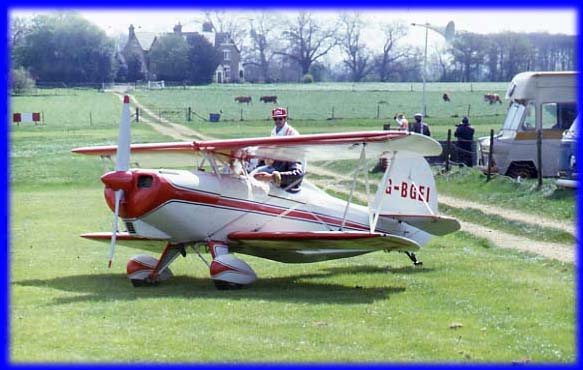 |
The Baby Great Lakes is, as its name
suggests, a scaled-down homebuilt version of an original pre-war
great Lakes design. It is minute: only 13 feet 9 inches long and
with a wing span of 16 feet 8 inches. Obviously, it is a single
seater. However, its small size confers an advantage: with a
Continental A-65 engine and gross weight of 850lb, it manages a
cruising speed of 120mph. Range is 250 miles (there isn't much space
for petrol!). It first flew in 1954.
This one was at
Old Warden, April 1981 |
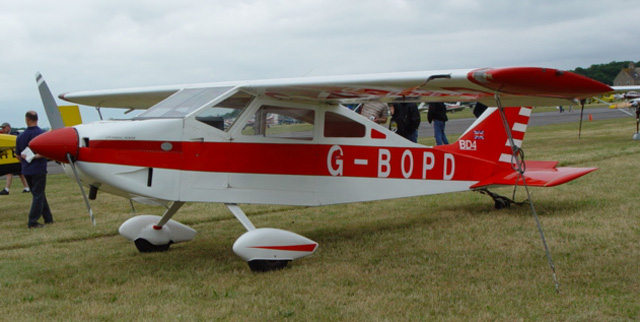 |
The Bede BD-4 was one of American designer
Jim Bede's more successful designs. It was marketed as a kit for
home construction. Most were built in the USA, including this one,
which first flew in 1974, and was imported into the UK in 1988. They
can be powered by a range of engines, from 108 to 180hp, giving top
speeds varying from 155 to 180mph. Wing span is 25 feet 6 inches;
length, 21 feet 10 inches; empty weight, 880lb (depending on
engine), maximum gross weight 1,800lb. It is a two seater. At a
casual glance, it is very easily confused with the earlier Wittman
Tailwind.
Photograph by Ivy at Kemble in July 2005. |
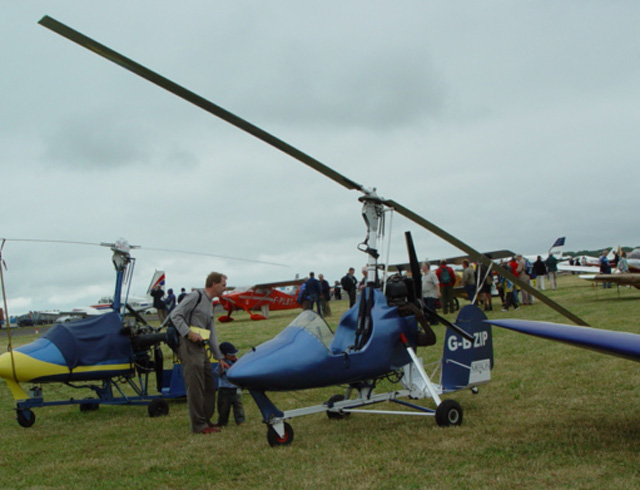 |
The Bensen B-8 is one of the most successful
models of autogyro in the world. Its main advantage is very simple
construction (in so far as `simple' can ever apply to a rotary
winged machine). As with all autogyros, the rotor is essentially
unpowered, the thrust being provided by the pusher propeller. First
flown by American designer Igor Bensen in 1955, they were originally powered
by a 90hp McCulloch engine of doubtful reliability. More recent kits
feature more robust engines, such as the Rotax 582 installed in this
example seen at Kemble in July 2005.
Length is 11 feet 4 inches and rotor diameter 20 feet. Empty weight
is 250lb and maximum gross weight 620lb. Maximum speed is 85mph.
Needless to say at those weights it is a single seater.
Photograph by Ivy |
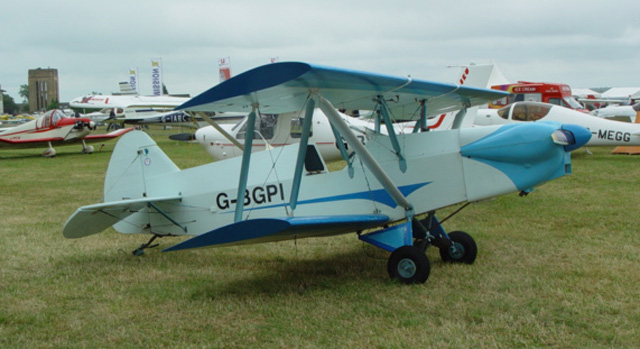 |
The Plumb BGP-1 is a one-off homebuilt
biplane, designed and built by Barry Plumb (hence the designation
and the registration). It is a single seater, powered by a converted
Volkswagen 1.8 litre engine. It first flew in 1986 and has been a
regular visitor to rallies and fly-ins in the UK ever since. Photograph
by Ivy at Kemble, July 2005. |
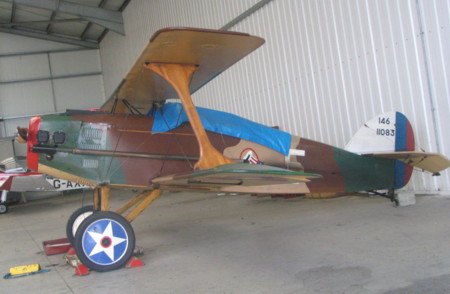 |
The Boredom Fighter was designed by New
Yorker Don Wolf. It is a wood and fabric design intended to simulate
a fighter of the first world war. The name is obviously ironic! It
is quite small - 15 feet 7 inches longg, with a wing span of 20 feet
- and very light, grossing only 770lb. A single seater, its
Continental A-65 engine manages to haul it along at 100mph.
This one (G-BNAI) was at Haverfordwest in
September 2007. |
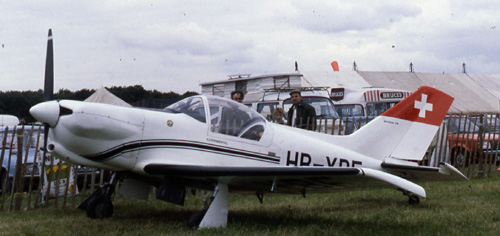 |
The Bouvreuil P-50 is a racy little single
seater designed by French designer M. Pottier. Its 90hp Continental
engine manages to give it an amazing maximum speed of 190mph! Note
the retractable undercarriage, very unusual in a machine weighing
only 880lb. It first flew in July 1979. It is 18 feet 4 inches long
and has a wing span of 20 feet 2 inches.
This one was at
Leicester, May 1980 |
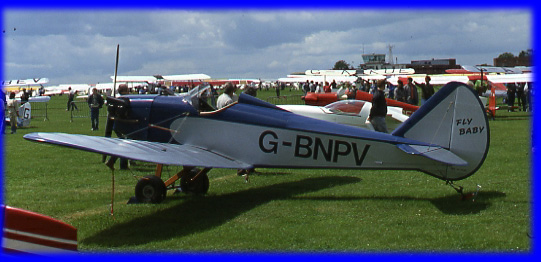 |
The Bowers Fly-Baby was designed by Peter
bowers while he was working as an engineer for Boeing. It is purely
a fine weather machine, having an open cockpit; and its Continental
C-90 engine allows it to potter along at 100mph. It first flew in
1960. Construction is fairly simple, wood and fabric. Gross weight
is 925lb; it is 18 feet 10 inches long, and the wing span is 28
feet.
This one was at
Cranfield, July 1988 |
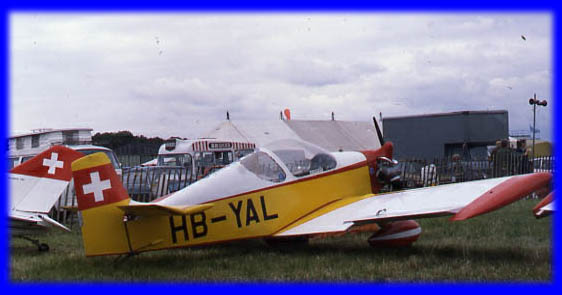 |
The Brugger Colibri MB2 is another diminutive
single seater, in this case designed by Swiss engineer Max Brugger.
It is a little wood and fabric machine, powered by a converted
Volkswagen car engine, which gives it a cruising speed of 100mph. It
weighs in at 727lb, is 15 feet 9 inches long, and has a wing span of
19 feet 8 inches.
This one was at Leicester, July 1980 |
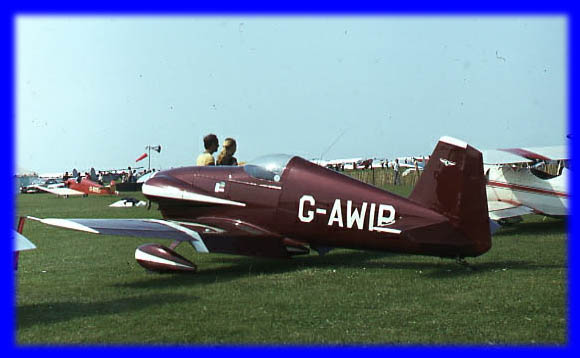 |
The Bushby-Long Midget Mustang is an advanced
aircraft for a homebuilt. It is all metal, and fully aerobatic. The
first one was designed, built and flown in 1948 by David Long, who at the
time was chief designer for Piper in the USA. The plans were bought
by Robert Bushby who then sold them to private individuals who
wanted to build them at home. This one was built in the UK and is
fitted with a Continental O-200 engine. It first
flew in 1973. Wing span is 18 feet 6 inches, Length 16 feet 5
inches. Top speed is a punchy 210mph and range 375 miles.
The photograph was taken at Cranfield in July
1983. |





|